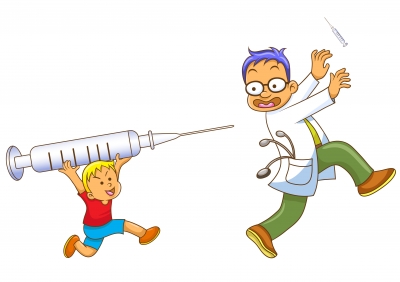The number of vaccines on the CDC list is continually growing. When I was a child I had just a few vaccines—polio and DTP. I had the measles, and so did my siblings. We now have lifetime immunity to the measles. When I breast fed my babies, they received protection from getting the measles as infants.
My children received approximately 18 doses of vaccines by age five. They received more doses of DTP and polio than I did. And they received the MMR vaccine.
A doctor visit often included a shot. We had a book that my daughter enjoyed. It was titled It’s Your Turn Doctor. The child in the story imagines what it would be like to give the doctor a physical exam. In the final page the child is chasing the doctor with a syringe.

The book was funny and we laughed. It made doctor visits easier. As the years passed I have become more concerned about the content of the syringe than the needle stick.
In 1982 I didn’t know that the MMR vaccine was developed from an aborted fetus. I was puzzled by the stomach pain, digestive disorder and pause in language development that I observed after this vaccine was given to my daughter.
The immunity offered by the MMR does not give lifetime immunity. Some cases of measles are caused by the vaccine and can infect others. A blood test can determine if a case of measles is the wild form or the vaccine type.
The CDC now recommends 35+ doses of vaccines for children by age five. Each injection contains additional substances; aluminum, formaldehyde, DNA fragments, mercury. You can find the ingredients in each vaccine here.
Why so many doses of vaccines–which ones have more benefits than risks? What has happened to the immune system that God provided us with? We can support the immune system with good nutrition, adequate hydration (pure water), rest and enough sleep. Sufficient rest might be a problem is our hectic lifestyles. It is worth it to slow down.
Because sexual behavior has changed dramatically over the past five decades, a vaccine was developed for an infection that can only be passed by sexual intimacy, blood or body fluid contact. The vaccine for hepatitis B was developed in the 1980s and in 1991 it was added to the recommended vaccines.
It is curious that a decision was made to give this vaccine to all newborn infants—despite the fact that all women are screened for hepatitis B during pregnancy. As a general practice the vaccine is given when the baby is 24 hours old. We don’t know if there are any longterm consequences from giving this vaccine to a newborn. We don’t know how long this vaccine is effective. It may wane by the teenage years.
The HPV vaccine is also developed for a sexually transmitted virus. It is recommended for girls, 11 to 12 years old to prevent cervical cancer. The truth is young women can be monitored by a pap smear when they are sexually active and treated appropriately. The problem with the HPV vaccine is the severe side effects some girls experience. The HPV vaccine has the largest amount of aluminum as an adjuvant.
It is interesting to note that other countries have omitted the MMR vaccine, the hepatitis B vaccine and the HPV vaccine from the recommended schedule. Japan does not give the MMR or the HPV vaccine. Instead Japan has an individual measles vaccine with less side effects. Japan, Finland and Denmark do not give the hepatitis B vaccine. In Sweden all vaccines are voluntary.
In 1992 New Zealand did a study comparing the health of vaccinated children against unvaccinated.
Another study was done in the United States and published in 2017.
In response to the current controversy over vaccines, the Association of American Physicians and Surgeon has stated their strong opposition to mandatory vaccines in the U.S. I hope you will take the time to understand this issue.
We can sign a petition to ask the President to establish a Vaccine Safety Commission. Click here to see the petition.
Sharing this post with Friendship Friday.



